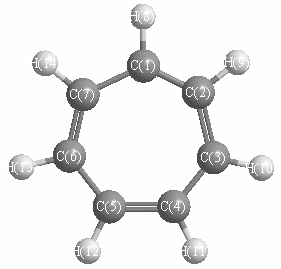Geometric Data

Point Group C2v
Internal coordinates
distances (r) in Å, angles (a) in degrees, dihedrals (d) in degrees
| Description |
Value |
unc. |
Connectivity |
Reference |
Comment |
| Atom 1 |
Atom 2 |
Atom 3 |
Atom 4 |
Cartesians
Atom - Atom Distances 
Distances in Å
Calculated geometries
for C
7H
7+ (cycloheptatrienyl cation).
Bond descriptions
Examples: C-C single bond, C=C, double bond, C#C triple bond, C:C aromatic bond
| Bond Type |
Count |
| C-C |
4 |
| C=C |
3 |
| H-C |
7 |
Connectivity
| Atom 1 |
Atom 2 |
| C1 |
C2 |
| C1 |
C7 |
| C1 |
H8 |
| C2 |
C3 |
| C2 |
H9 |
| C3 |
C4 |
| C3 |
H10 |
| C4 |
C5 |
| C4 |
H11 |
| C5 |
C6 |
| C5 |
H12 |
| C6 |
C7 |
| C6 |
H13 |
| C7 |
H14 |
Dipole, Quadrupole and Polarizability
Electric dipole moment 
| State |
Config |
State description |
Conf description |
Exp. min. |
Dipole (Debye) |
Reference |
comment |
Point Group |
Components |
| x |
y |
z |
total |
dipole |
quadrupole |
| 1 |
1 |
2A2 |
C2v |
True |
|
|
|
|
|
|
C2v |
1 |
2 |
| 1 |
2 |
2A" |
Cs |
False |
|
|
|
|
|
|
Cs |
2 |
3 |
Experimental dipole measurement abbreviations: MW microwave; DT Dielectric with Temperature variation; DR Indirect (usually an upper limit); MB Molecular beam
Calculated electric dipole moments for
C
7H
7+ (cycloheptatrienyl cation).
Electric quadrupole moment 
| State |
Config |
State description |
Conf description |
Exp. min. |
Quadrupole (D Å) |
Reference |
comment |
Point Group |
Components |
| xx |
yy |
zz |
dipole |
quadrupole |
| 1 |
1 |
2A2 |
C2v |
True |
|
|
|
|
|
C2v |
1 |
2 |
| 1 |
2 |
2A" |
Cs |
False |
|
|
|
|
|
Cs |
2 |
3 |
Calculated electric quadrupole moments for
C
7H
7+ (cycloheptatrienyl cation).






